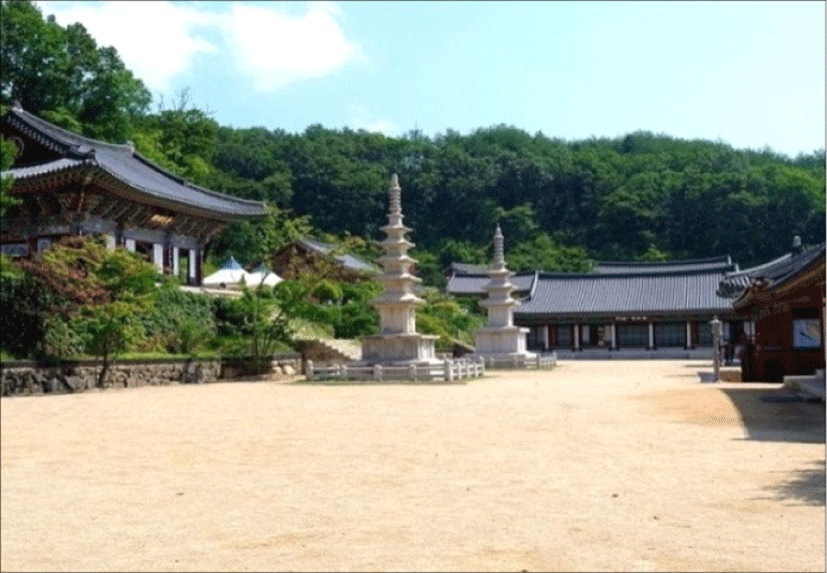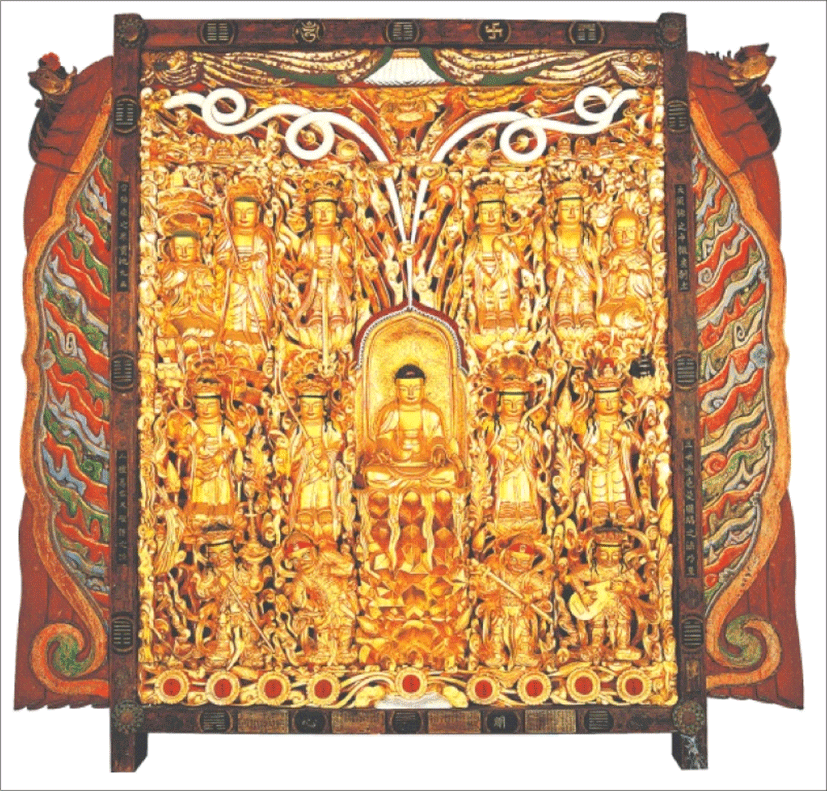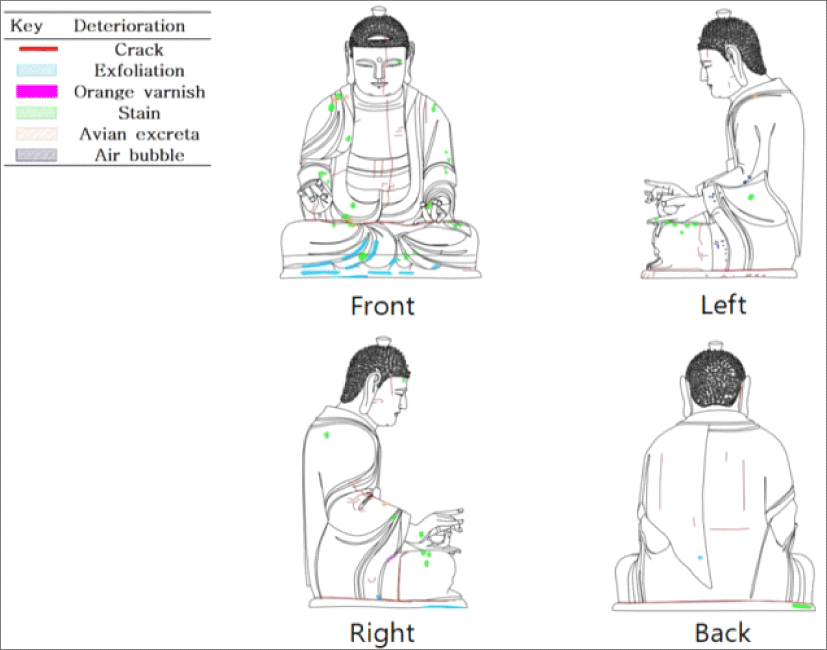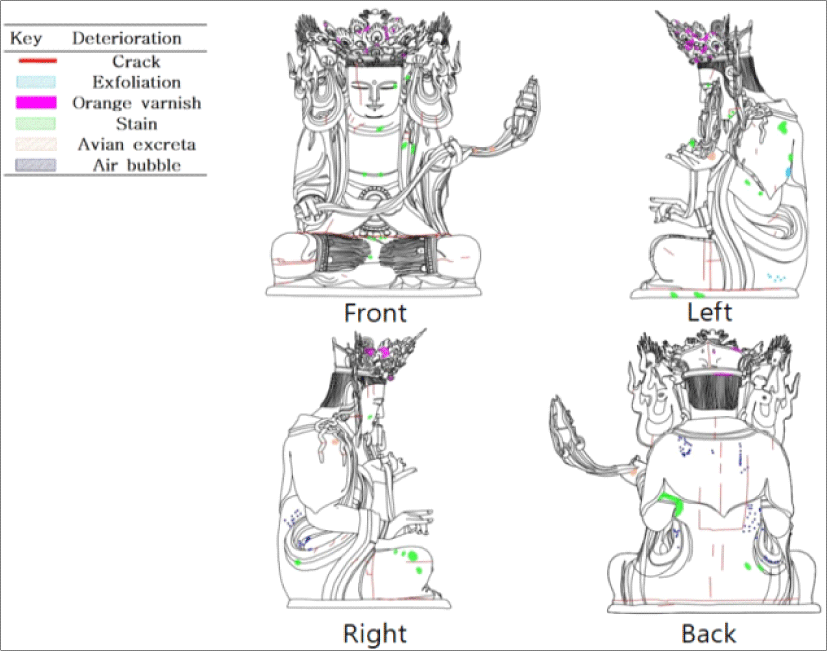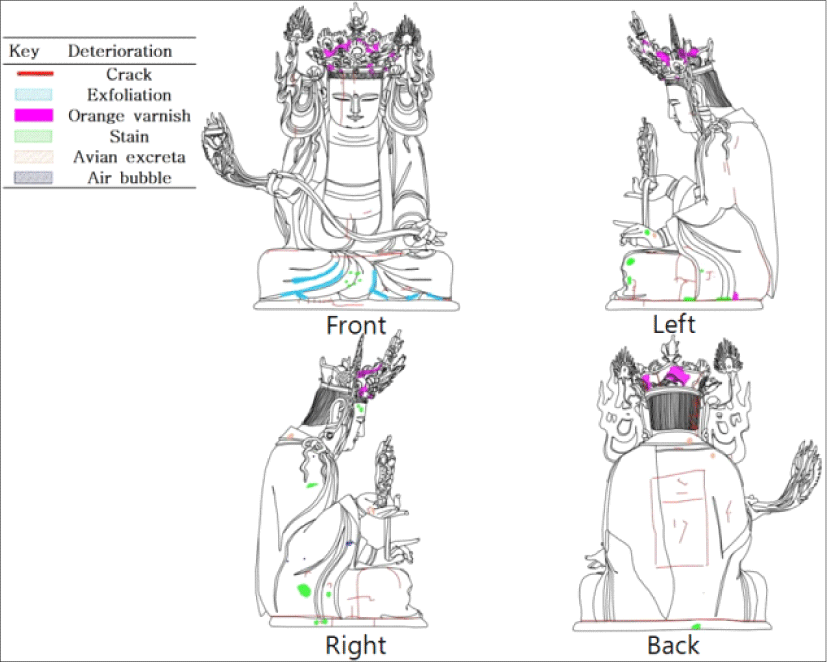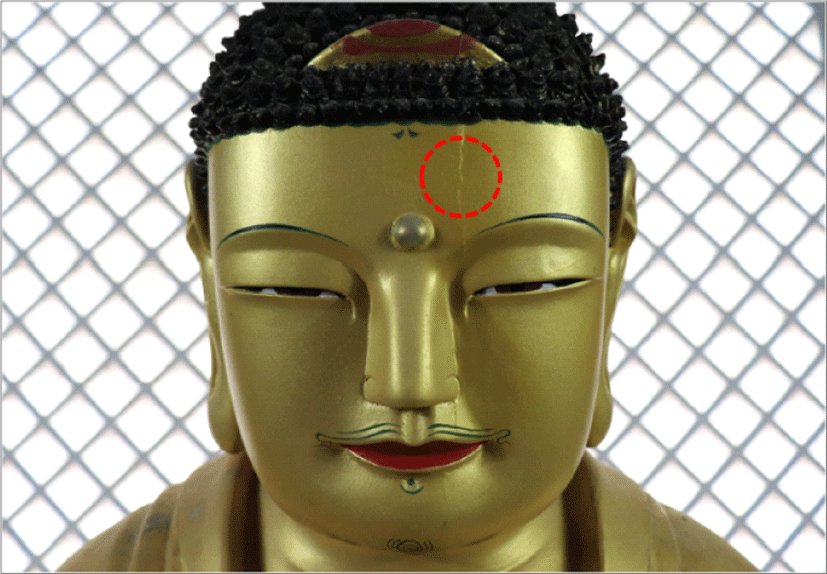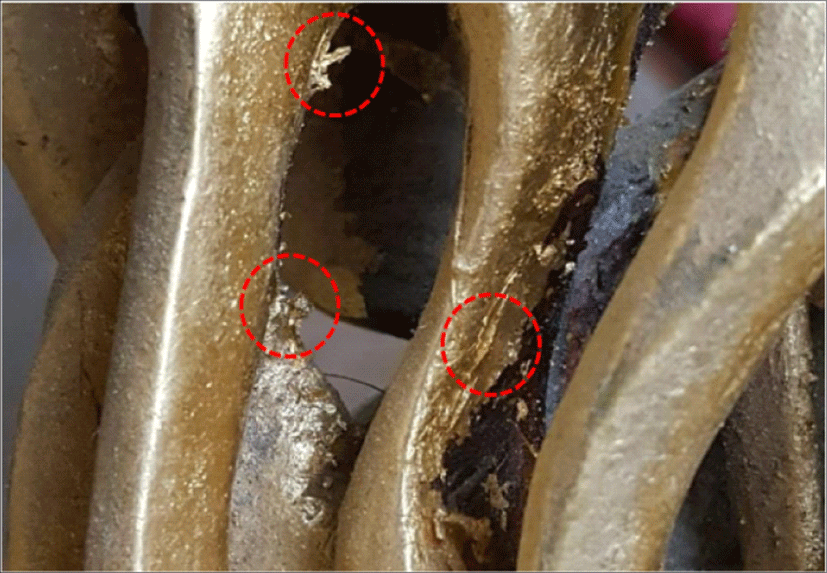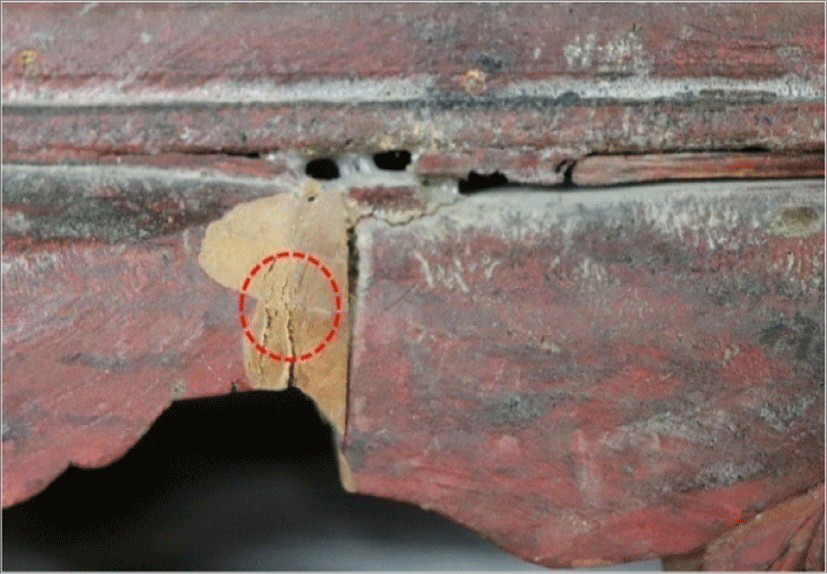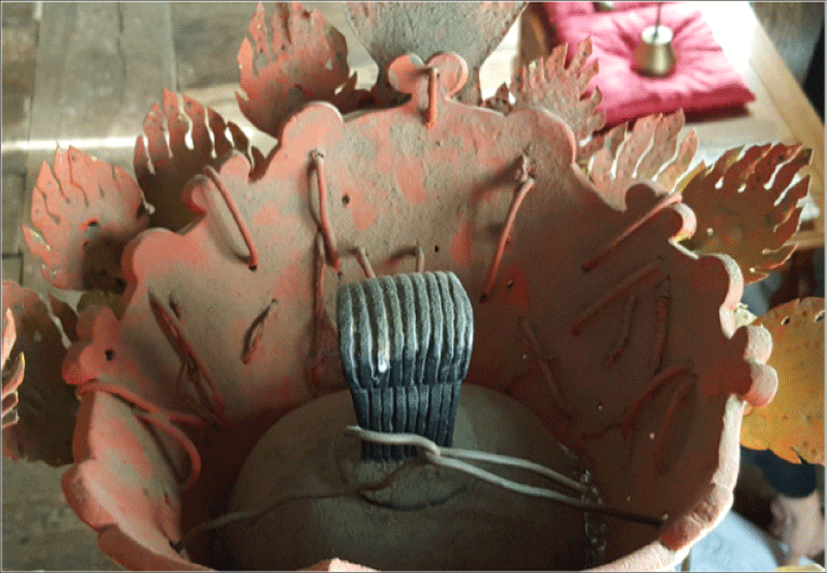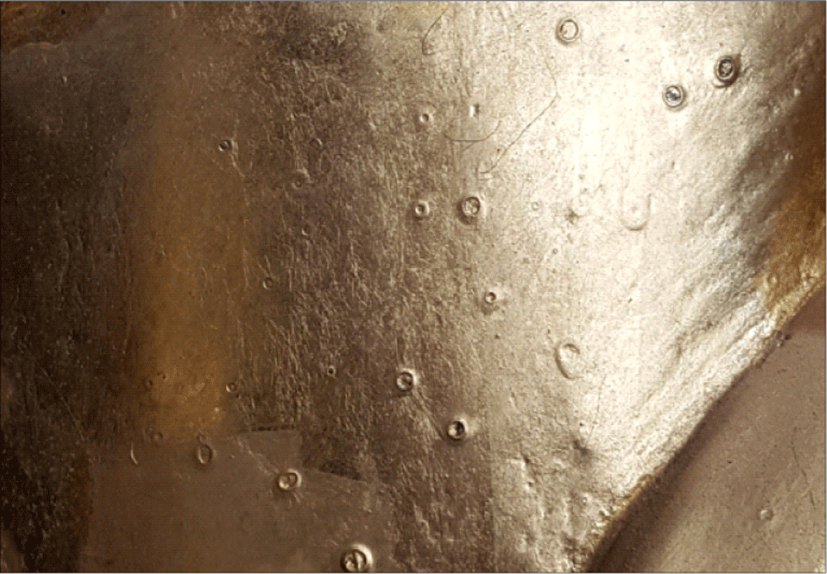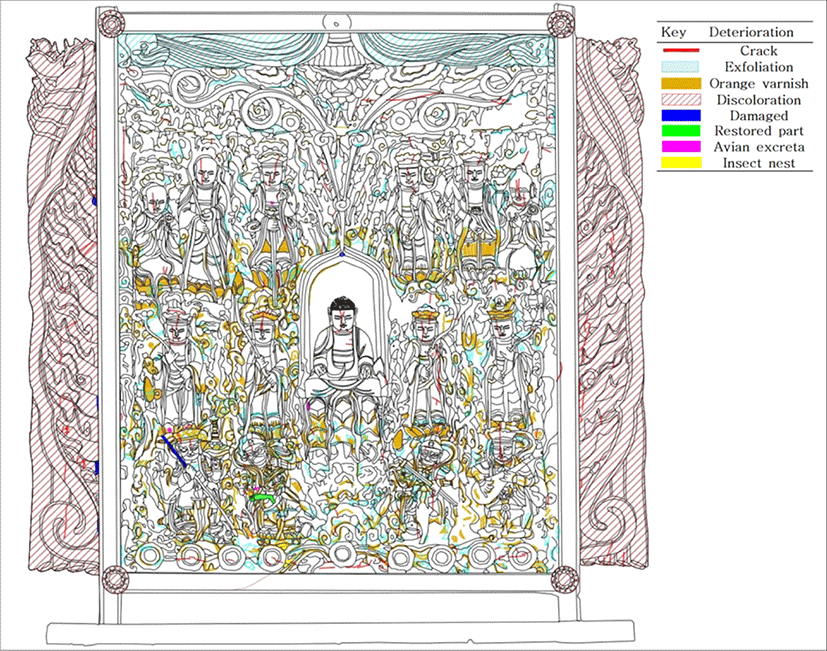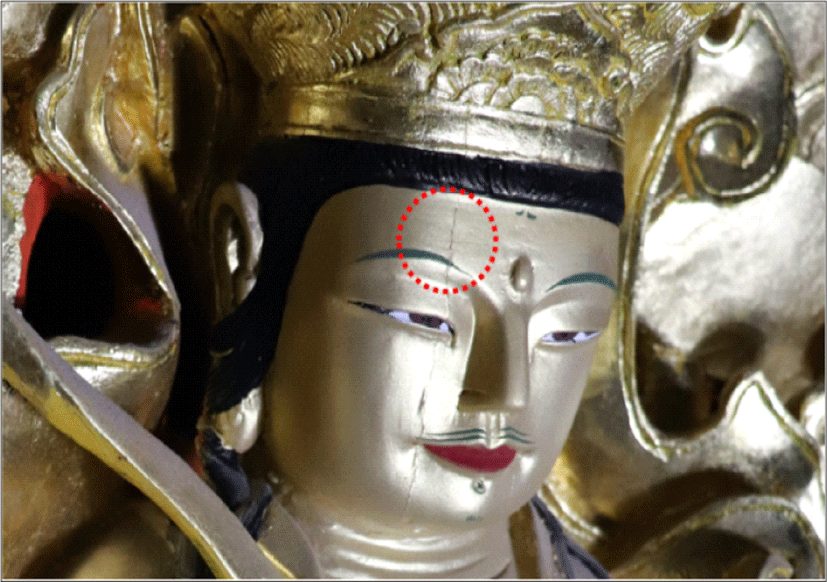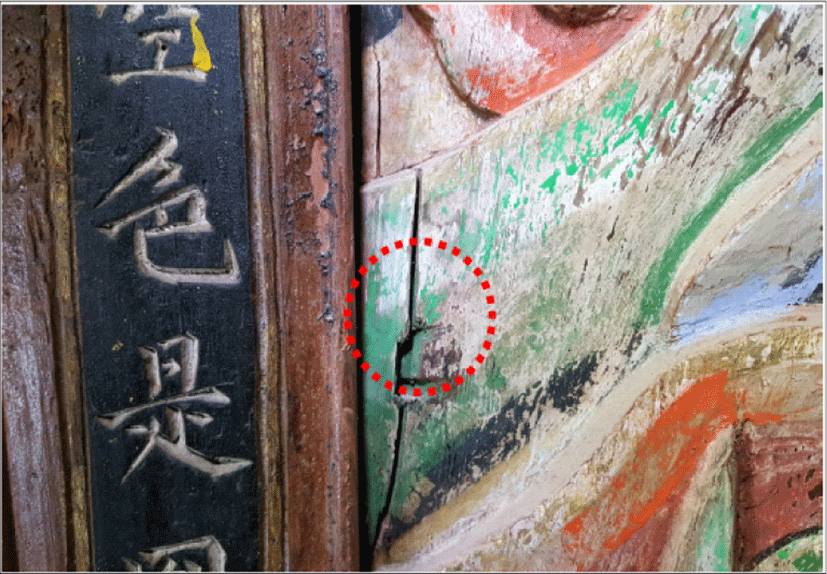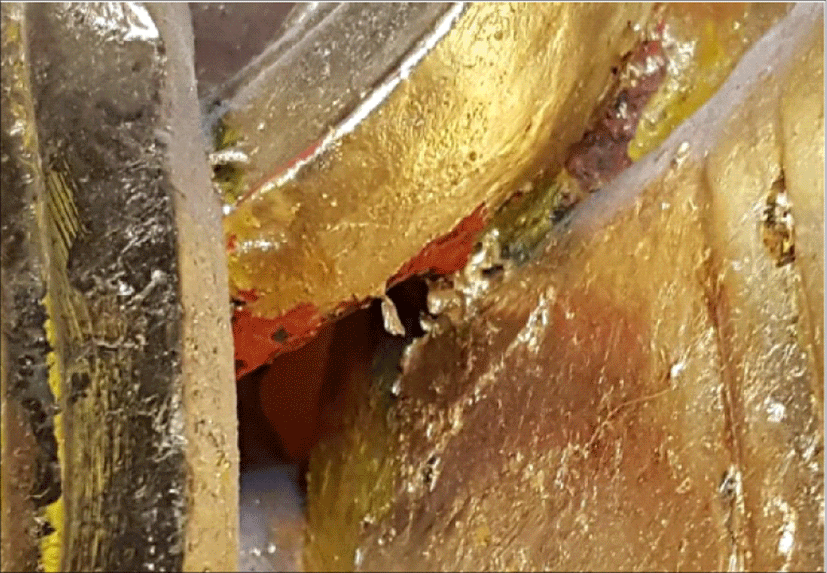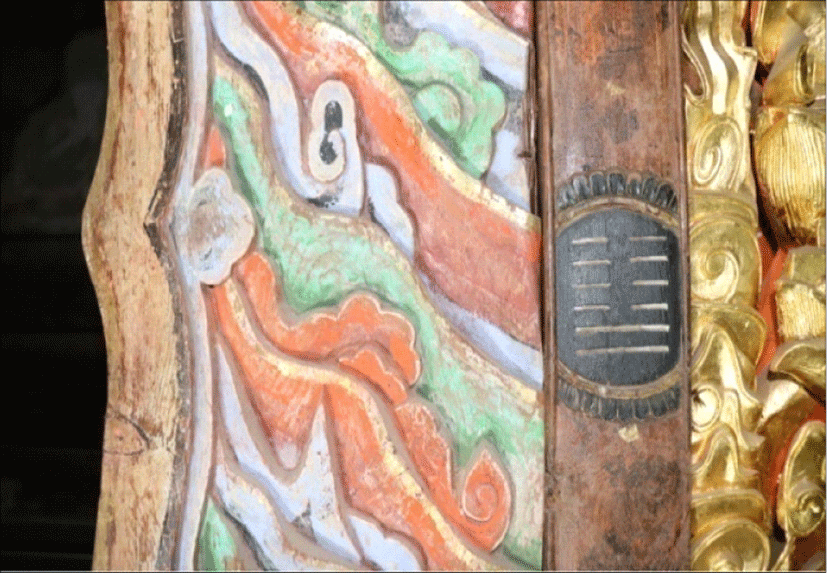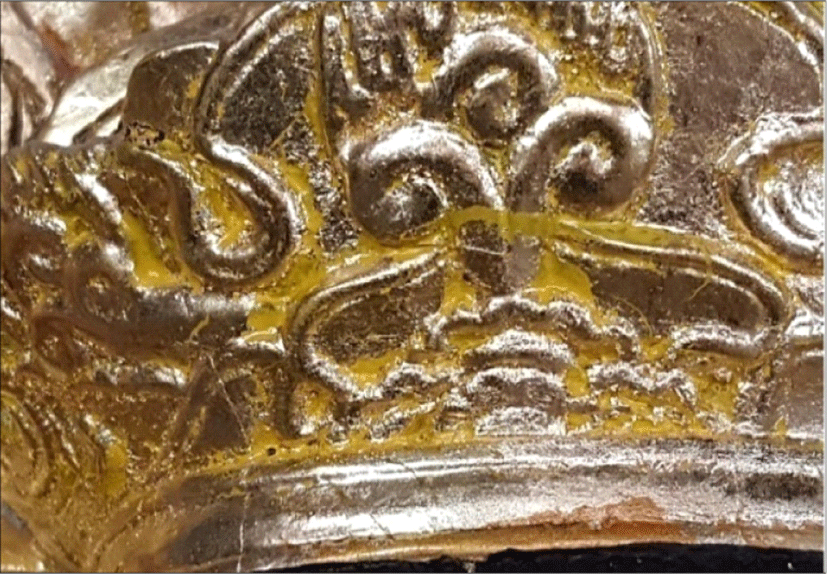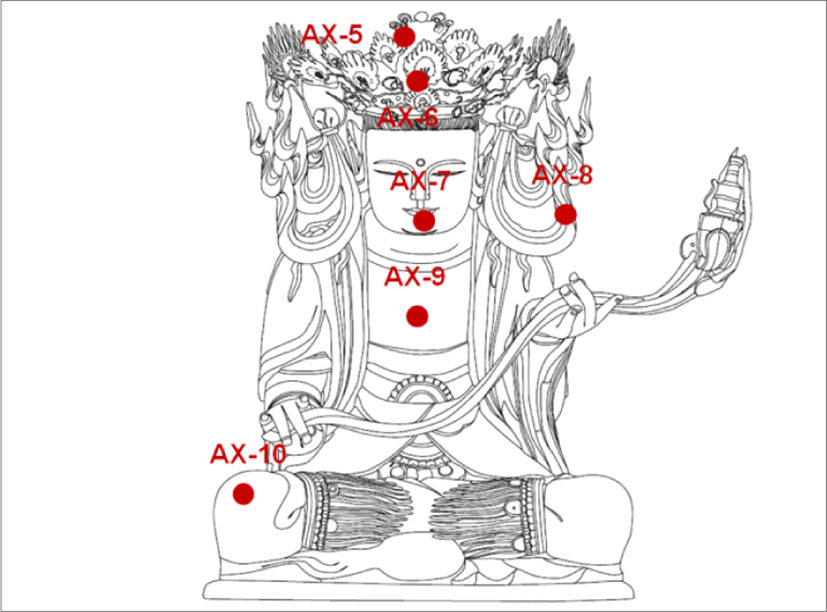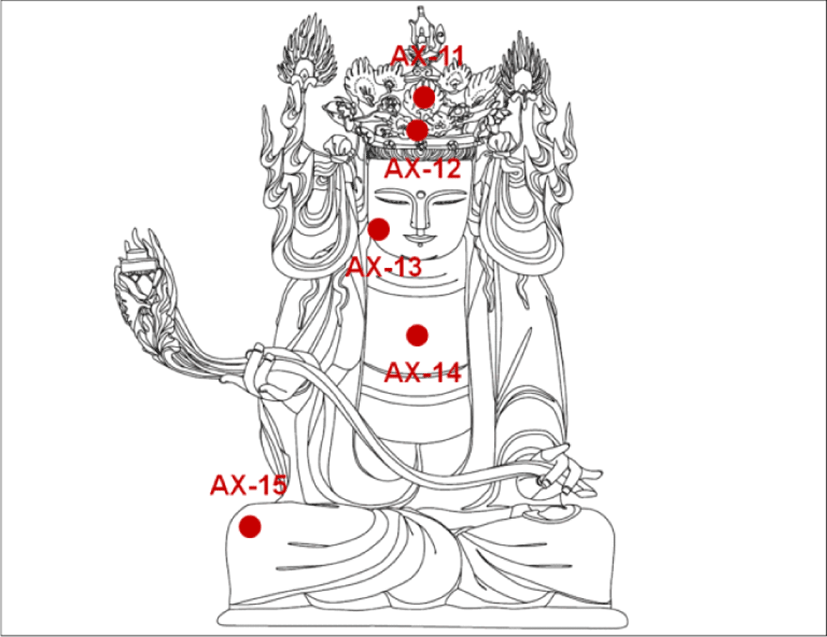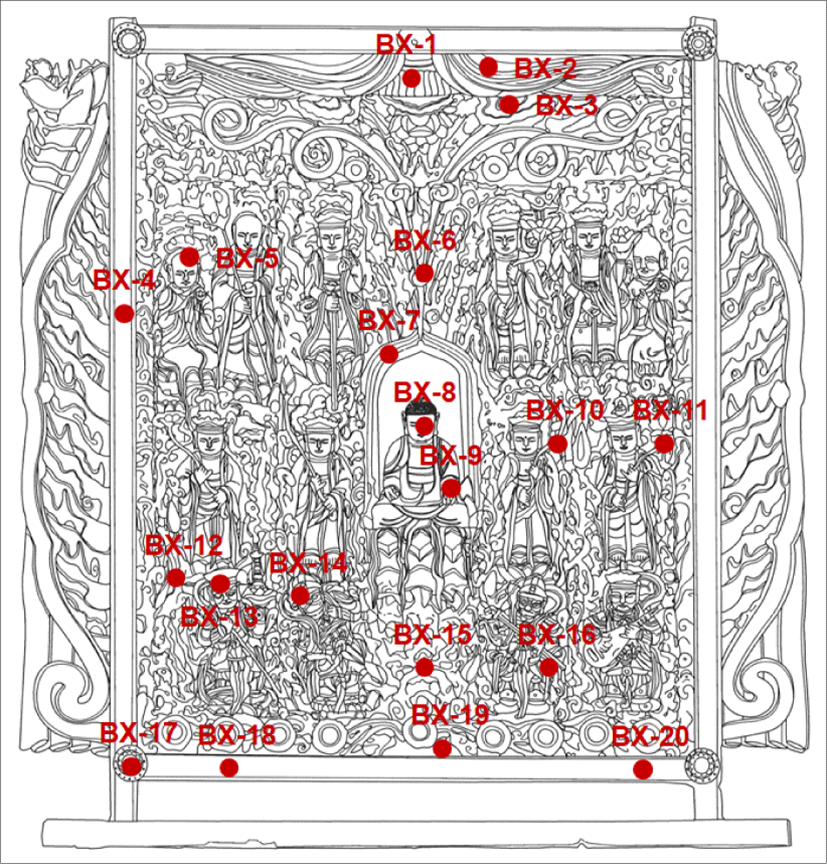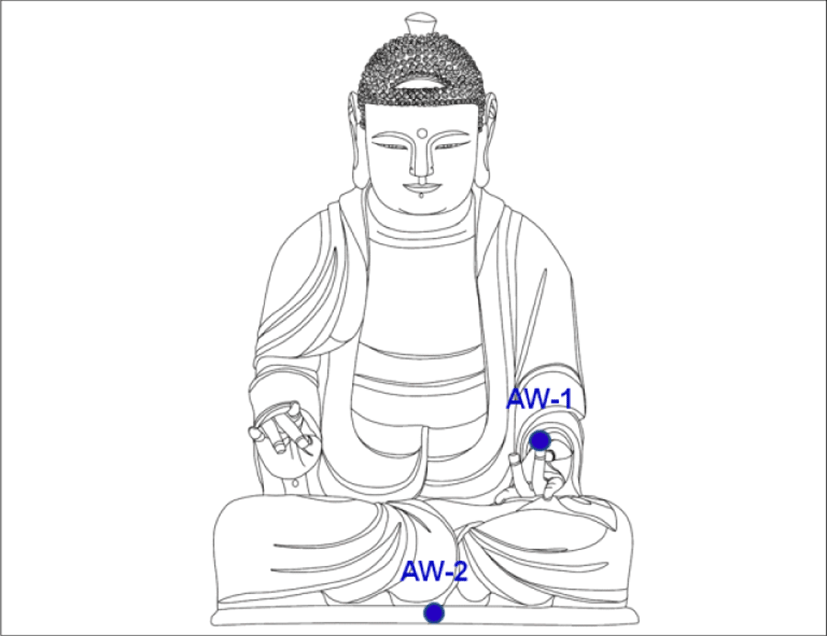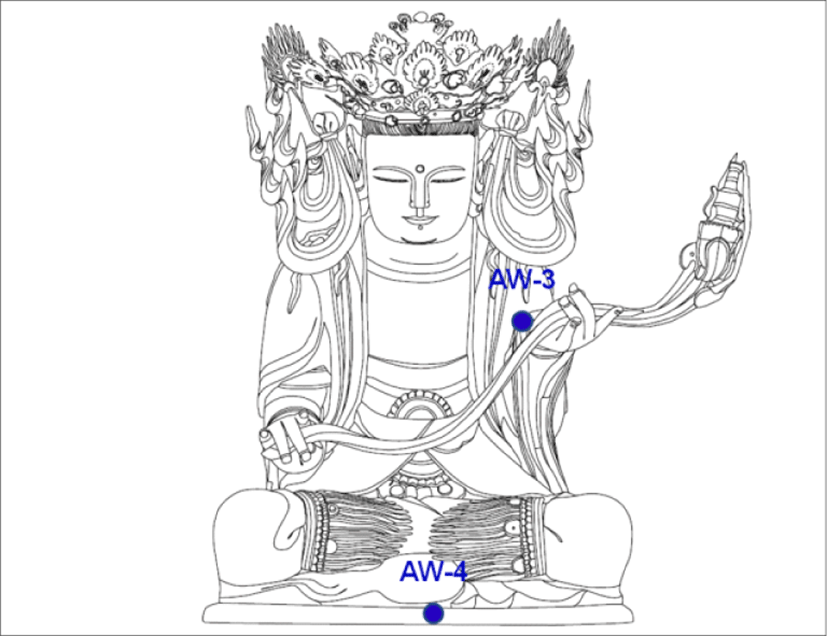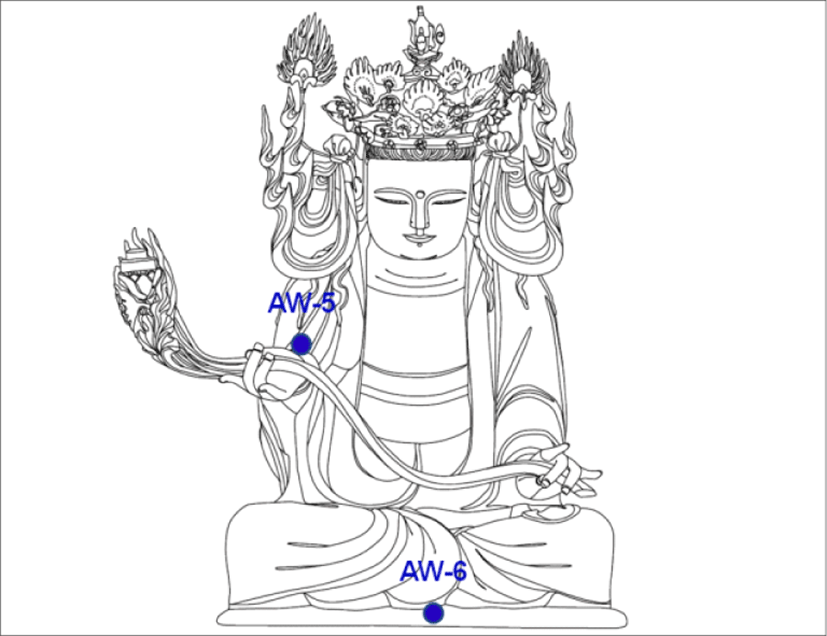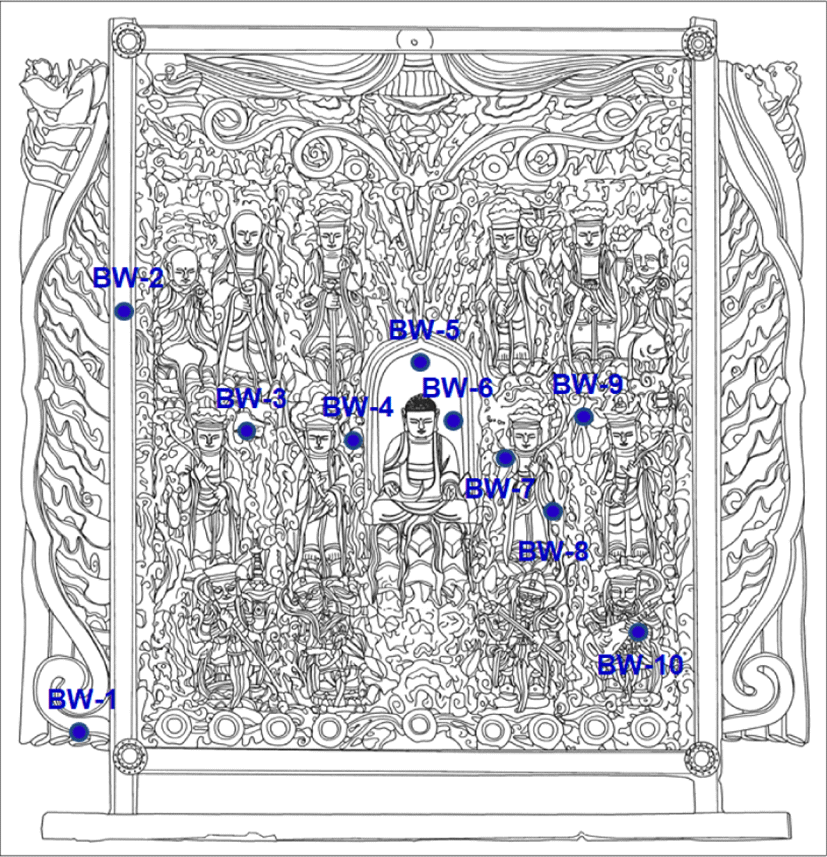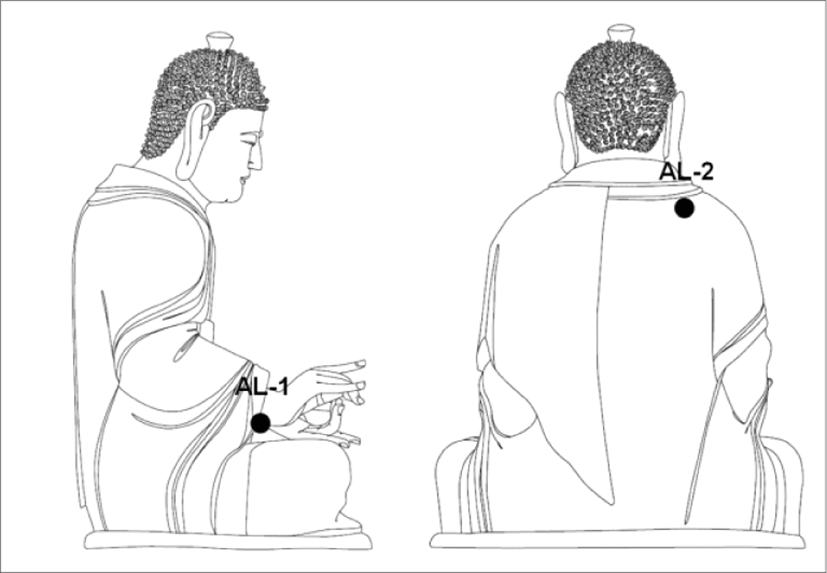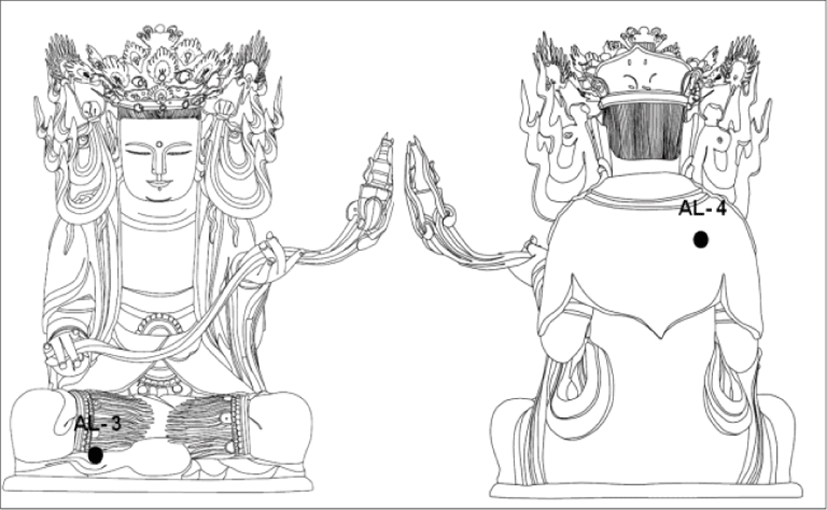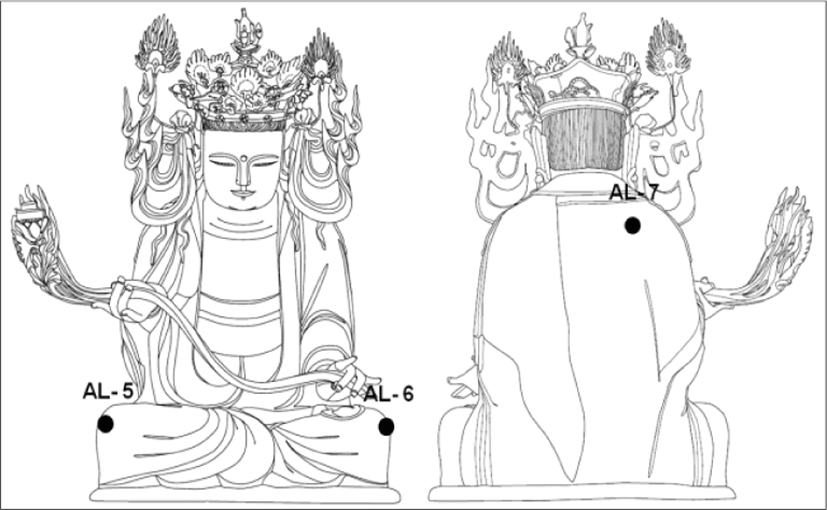1. INTRODUCTION
Yongmunsa Temple was built by Master Duwun in 870 A.D. according to the Royal Edict of Labor Exemption Issued to Gimryongsa Temple. In 1166 A.D., King Uijong ordered to rebuild the temple. Jehadang Pavilion, Jeokmukdang Pavilion and Beomjongnu Pavilion were rebuilt in Joseon dynasty. In 1835 A.D., Yongmunsa Temple was completely incinerated and the monks rebuilt the temple in 1840 A.D. (Dooyoung Conservation of Cultural Heritage, 2019a).
Today, Daejangjeon Hall, Bogwangmyeongjeon Hall, Uenghyanggak Pavilion, Jingyounggak Pavilion, Myeongbujeon Hall, Uengjinjeon Hall, Hoejeonmun Gate, and Beomjongnu Pavilion are the remaining Yongmunsa Temple buildings (Fig. 1). Designated cultural heritage in Yongmunsa Temple are Daejangjeon Hall and Rotating Sutra Cases (National Treasure), Royal Edict of Labor Exemption Issued to Yongmunsa Temple (Treasure) and Wooden Seated Amitabha Buddha Triad and Wooden Amitabha Buddha Altarpiece (Treasure) (Academy of Korean Studies, 1996).
Wooden Seated Amitabha Buddha Triad (Buddha Triad) and Wooden Amitabha Buddha Altarpiece (Buddha Altarpiece) are located in Daejangjeon Hall, Yongmunsa Temple, Yecheon, Korea (Fig. 2). According to excavated relics and related documents and Royal Edict of Labor Exemption Issued to Yongmunsa Temple, Buddha Triad and Altarpiece were made in 1684 A.D. Buddha Altarpiece is located behind the Buddha Triad and sculpture techniques of both wooden sculptures are similar to each other. Especially, formation and shape of main Buddha are very similar in view of history of Buddhism art and sculpture making techniques, so same sculptor is assumed to have made the two artifacts. According to excavated relics and related documents, monk Daneung and Takmil, the most prominent sculptors of late 17th century in Joseon, made Buddha Triad and Altarpiece in 1684 A.D.
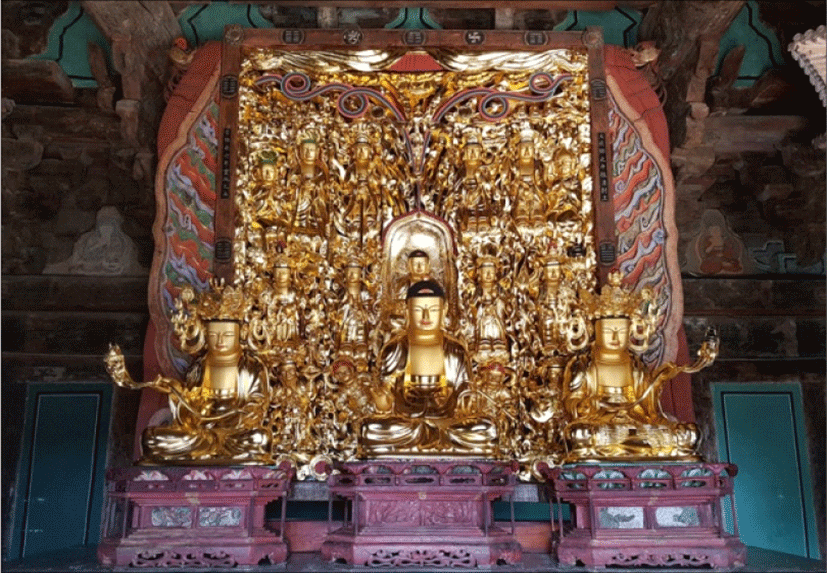
In the proximity of Yongmunsa Temple is the Daeseungsa Temple in Mungyeong (Fig. 3). Also, another Wooden Amitabha Buddha Altarpiece made by monk Daneung and Takmil is in Daeseungsa Temple. Sculpture technique and style of both Buddha Altarpieces are very similar. However, in Yongmunsa Temple, Buddha Triad still remains in front of Buddha Altarpiece. Buddha Altarpiece is a large scale wooden sculpture, and only six of them remain in Korea. Buddha Altarpiece is highly significant when studying the style of wooden Buddha sculpture in late 17th century in Joseon dynasty. In Korea, cultural heritage were classified as national treasure and treasure (Han and Lee, 2021; Han et al., 2021). Because of its historic and academic values, it was designated as Treasure (Dooyoung Conservation of Cultural Heritage, 2019b).
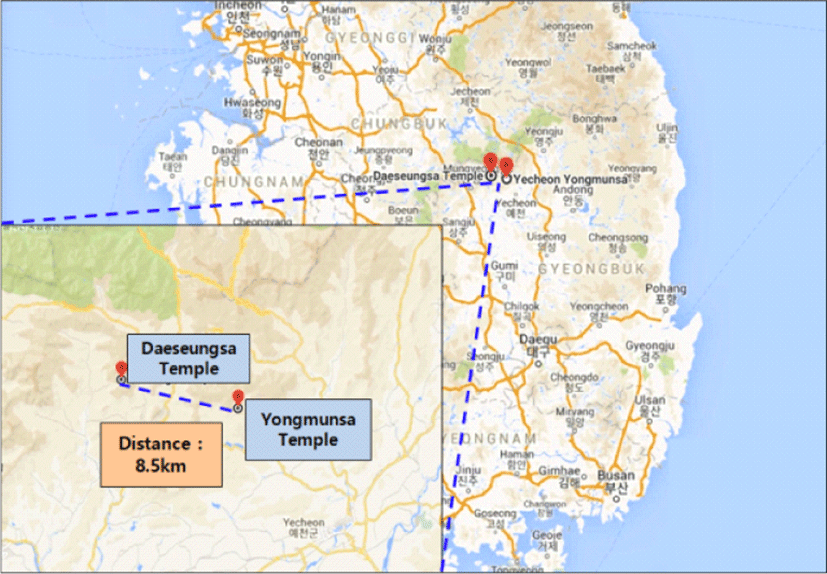
Buddha Triad is located in front of Buddha Altarpiece, and the Amitabha Buddha is located in the center as the main Buddha. Avalokitesvara Bodhisattvas and Mahasthamaprapta Bodhisattvas are located in the side of Amitabha Buddha as attendant Buddha (Fig. 4). Also octagonal pedestal and lotus patterned pedestal remain and is expected to have been made with the Buddha Triad (Kwon, 1994).
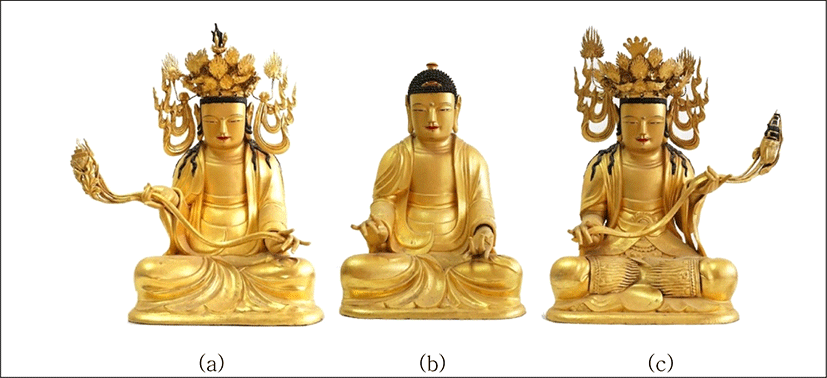
The height and width of Buddha Altarpiece are 265.5 cm and 218 cm respectively. It is the only wooden sculptures with cloud light pattern in front of the main Buddha. Also accessory parts were attached in both side of altarpiece. This altarpiece was made by attaching twelve pieces of wooden blocks and Buddha sculpture. Amitabha Buddha was placed in the center, with the Avalokitesvara Bodhisattvas and Mahasthamaprapta Bodhisattvas placed to the sides (Fig. 5). Buddha Triad and Altarpiece were sculpted by wood. Korean lacquer, clay and ash were used for the base layer. After completing the base layer, lacquer was varnished more than 4 times and gold leaf layer was coated in the surface of Buddha sculpture. Lacquerware artifacts managed to avoid severe damage from external conditions. Also these wooden sculptures are kept in Daejangjeon Hall which protected them from external degradation factors. However, exfoliation of gold leaf layer, physical damage and polymer degradation due to temperature and humidity changes, and biological degradation from insect and fungi can be observed in both Buddha Triad and Altarpiece.
Research on the analysis of wooden Buddha statues in Korea has been actively conducted since the late 2000s. Wooden Vairocana Buddha in Haeinsa Temple was identified as juniper trees in through wood species identification (Park et al., 2010). Buddha statues in the late Joseon Dynasty confirmed that ginko tree, pine tree, alder tree and willow tree were used through analysis (Park et al., 2010). Wood species identification and scanning electron microscope – energy dispersive X-ray spectrometer (SEM-EDX) analysis were conducted on Seated Wooden Avalokitesvara Bodhisattva in Bogwangsa Temple, Andong, and confirmed that it were made of gold leaf and juniper tree (Lee, 2013). Amitabha Buddha Lotus Pedestal in the Geungnakjeon Hall of Ssangbongsa Temple were identified as pine and ginko tree through wood species identification (Kim et al., 2012). Tree-ring dating was conducted on Buddha statues in Myeongbujeon Hall of Jeondeungsa Temple and analyzed that age was 1634 to 1642, and the wood species were identified as ginkgo and pine tree (Park et al., 2013). Clay Seated Vairocana Buddha Triad of Seonunsa Temple were identified as pine tree through wood species identification (Lee et al., 2020).
Various studies have been conducted on the wood species and materials analysis of wooden Buddha statues, there was no ceratin scientific analysis on the Wooden Amitabha Buddha Triad and the Wooden Amitabha Buddha Altarpiece in Yongmunsa Temple, which encompass wooden Buddha statues and wooden altarpiece (Hwang et al., 2020; Lee et al., 2021a, 2021b; Nam and Kim, 2021).
For these reason, scientific analysis was carried out for the precise diagnosis and to understand condition of Buddha Triad and Altarpiece. Visual inspection were conducted to construct deterioration map for artifacts. Also, portable X-ray fluorescence analysis (p-XRF), wood species identification and lacquer layer analysis were carried out to figure out the original material and characteristic of wooden sculptures. These scientific analysis results and database could be applied for authentic conservation and restoration studies.
2. MATERIALS and METHODS
Amitabha Buddha is located in center as the main Buddha. Avalokitesvara Bodhisattvas and Mahasthamaprapta Bodhisattvas are located in the side of Amitabha Buddha as attendant Buddha. The height of Buddha Triad are approximately 90 cm. Buddha Triad were made of wooden statue with lacquer, clay, ash and gold leaf. Scientific analysis were conducted to figure out the making technique.
Buddha Altarpiece is the only wooden sculpture with a cloud light pattern in front of the main Buddha. Also, accessory parts were attached in both sides of altarpiece. It was made by attaching twelve pieces of wooden blocks and Buddha sculptures. Amitabha Buddha was located in the center, with the Avalokitesvara Bodhisattvas and Mahasthamaprapta Bodhisattvas placed to the sides. Buddha Altarpiece were sculpted by wood and lacquer, clay, ash, gold leaf were used. The height and width are 265.5 cm and 218 cm respectively. Scientific analyses were conducted to figure out the making technique.
Deterioration map of Buddha Triad and Altarpiece were made by visual inspection (National Research Institute of Cultural Heritage, 2010). Deterioration conditions were classified as wood and gold leaf layer crack, exfoliation, pigments stain, orange varnish, and avian excreta.
p-XRF was used to analyze pigment, material and restoration parts of Buddha Triad and Altarpiece. p-XRF irradiates the X-ray on the sample, exciting it to exhibit fluorescence, from which quantitative component analysis can be carried out. Since irradiated X-ray hits the surface of object, the atom is excited and discharges distinct X-ray beams. With this mechanism, component analysis is possible (National Research Institute of Cultural Heritage, 2018; Skoog et al., 2008). Before p-XRF analysis, calibration were performed using calibration check coin. p-XRF (Delta, Innov-X system, USA) data were collected in 10–40 kV of voltage and 10–50 μA of current condition. Analysis was carried out with soil and alloy mode of 15 seconds for each beam, total 30 seconds.
Identification of wood species is carried out to identify wood species of Buddha Triad and Altarpiece. Wood samples were carefully taken from inconspicuous area of sculptures.
Identification of wood species is carried out by creating slices of samples of 20–30 μm width with a razor blade (ST-300, Dorco, Seoul, Korea) and microtome blade (YL-MBA35, YLS, Guri, Korea) for the cross, radial and tangential sections. The created slices are dyed in safranin (1%, aqueous solution) for 2 minutes and washed thoroughly before being placed on the slide glass. To complete the preparat, glycerine (50%, aqueous solution.) is used to mount the sample with cover glass and slide glass. Optical microscope (Eclipse Lv 100, Nikon, Tokyo, Japan) is used to identify the anatomical characteristics of wood species. The wood species are determined according to the standards set by Korean wood anatomy references and International Association of Wood Anatomists (IAWA): List of Microscopic Features for Identification (Kim and Choi, 2016; Kim, et al., 2016b; Kwon et al., 2020; Lee, 1997a, 1997b, 1997c, 2003; National Folk Museum of Korea, 2004; National Research Institute of Cultural Heritage, 2015, 2016a; Park, 2006). Final confirmations are made by comparing with the samples from Conservation Laboratory for the Wooden Cultural Heritage, Korea.
For the layer observation, lacquer layer analysis was carried out to find out the lacquer technique of Buddha Triad and Altarpiece. In disassemble process of sculpture, lacquer layer analysis sample were collected.
Cross section direction was confirmed using microscope and the sample was fixed on a silicon frame to be cured using epoxy resin. The cured epoxy resin was cut using a micro cutting machine and a slice of 20–30 μm width was crafted using a polishing paper (Choi and Kim, 2018). This slice was placed on the slide glass, and mounting medium was inserted and covered with a cover glass to create a preparat for lacquer layer observation, which was observed using an optical microscope.
3. RESULTS and DISCUSSION
Visual inspection of Buddha Triad and Altarpiece were carried out. Naked eye observation and documentation were carried out to create deterioration map of sculptures (Fig. 6–8).
Amitabha Buddha of Buddha Triad had cracks around the legs and the center of the face (Fig. 9). The gold leaf layer is assumed to have cracked as the base wood expanded and contracted according to the environment and relative humidity (Fig. 10). Also, for the front side, a long crack was found from the neck to the abdominal area. Furthermore, overall gold leaf layer was lifted or peeled, exposing the lacquer layer.
In the case of Avalokitesvara Bodhisattvas, cracks occurred mainly where the wooden sculpture parts were constructed. Also, exfoliation of gold leaf layer was confirmed near the cracks, and exfoliation was also visible near delicate areas such as accessory or edge of clothing.
Mahasthamaprapta Bodhisattvas of Buddha Triad was also cracked mainly on the face along with minor cracks overall. Moreover, exfoliation of gold leaf layer was severe around the right leg. In addition, pigment stain, orange varnish, bubbles during gold leaf coating, and avian excretion were observed (Fig. 11–13). Such various damages and deterioration were marked in detail in the deterioration map.
As for the Buddha Altarpiece, crack was found overall for the central main Buddha, which is Amitabha Buddha along with attendant Buddha to the sides (Fig. 14). Crack was found near the lower part of lotus pattern and exfoliation of gold leaf layer was observed near the cracked area (Fig. 15–19).
Traditional Korean pigment mixes natural adhesion such as cowhide glue or fish glue, but the pigment layer discolors as time passes because such adhesion dissolves. The discoloration occurred overall for the entire Wooden Amitabha Buddha Altarpiece (Lee, 2015). Also, parts of the wooden sculptures were also missing. Coronet accessory of Mahasthamaprapta Bodhisattvas and other accessory of West Guardian King were damaged and lost.
Moreover, areas that were restored using modern materials were confirmed. Generally, Korean lacquerware use lacquer as adhesion for the gold leaf layer, but restored parts using orange pigment and synthetic resin. Also yellow pigments were observed in gold leaf layer.
Deterioration map was made for each artifacts using the visual investigation results, facilitating the visual understanding of damage conditions. Crack, gold leaf layer exfoliation, degradation of pigment, orange pigment assumed to be recently applied, restored areas that use modern materials and avian excretion were confirmed. The conservation status of Buddha Triad and Altarpiece is determined to be highly vulnerable. Furthermore, the artifact is exposed to external environment, requiring Integrated pest management or regular monitoring for safe maintenance.
p-XRF were carried out for the two main purpose; pigment components analysis and accessory material analysis.
35 point p-XRF analysis was conducted as in Fig. 20–23 to confirm the main components of Buddha Triad, Altarpiece and accessory parts.
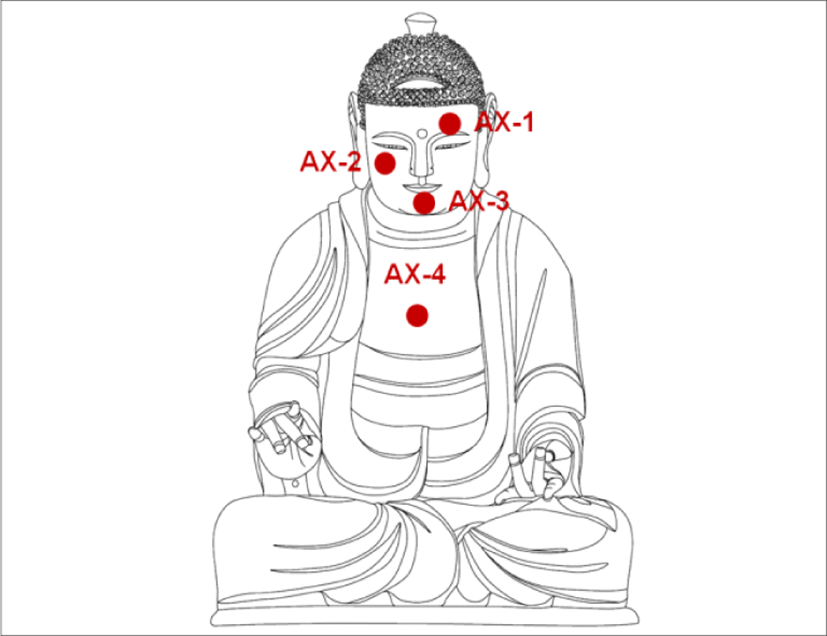
The p-XRF component analysis results of Amitabha Buddha are as in Table 1. Chrome (Cr) was detected from green color pigment, implying the usage of chrome oxide green. Cadmium (Cd), sulfur (S), mercury (Hg) and lead (Pb) were detected from red color pigment, so cadmium red, cinnabar and minium is expected to have been used. Gold (Au) was detected from gold color, so gold was likely used (Jeong, 2001; National Research Institute of Cultural Heritage, 2013, 2016b).
The p-XRF component analysis results of Avalokitesvara Bodhisattvas are as in Table 2. Copper (Cu) was detected as the main component of coronet accessory, meaning that copper was its main ingredient. Mercury (Hg), cadmium (Cd) and lead (Pb) were detected from red color pigment, implying usage of cadmium red, cinnabar, minium and Gold (Au) was detected from gold color, implying the usage of gold (Jeong, 2001; National Research Institute of Cultural Heritage, 2013, 2016a).
p-XRF component analysis results of Mahasthamaprapta Bodhisattvas were as in Table 3. Copper was detected from coronet accessory, implying it was made from copper, and Gold was detected from the gold color, implying the usage of gold (Jeong, 2001; National Research Institute of Cultural Heritage, 2013, 2016b).
p-XRF component analysis results of Buddha Altarpiece were as in Table 4. Lead (Pb) was detected from white color pigment, implying the usage of lead white and chrome (Cr), mercury (Hg), lead (Pb) and iron (Fe) were detected from red color pigment, implying the usage of cadmium red, cinnabar and hematite. Copper (Cu) and chrome (Cr) were detected together for green color pigment, implying the usage of chrome oxide green and malachite. Lead (Pb) was mostly detected for orange color pigment, implying the usage of minium. Finally, main element was not detected for black color pigment, suggesting that ink stick, which is mainly composed of carbon, was used.
Pigment and material were analyzed through p-XRF. Green color pigment was malachite and chrome oxide green, gold color was gold, red color pigment was cadmium red, minium, hematite, and cinnabar, white color pigment was lead white, black color pigment was ink stick (Carbon), and coronet accessory was determined to be made of copper. Cadmium red and chrome oxide green are synthetic chemical pigment likely to be produced in modern day.
The location of species identification was six points from Buddha Triad and ten points from Buddha Altarpiece as can be seen in Fig. 24–26. Analysis of Buddha Triad showed three samples of Tilia spp., two samples from Abies spp., and one sample from Pinus spp. (Fig. 27–32). Samples collected from Amitabha Buddha, Avalokitesvara Bodhisattvas and Mahasthamaprapta Bodhisattvas were identified to be Tilia spp. and bottom part which is used to seal excavated relics was identified to be two samples of Abies spp. and one sample of Pinus spp. (Fig. 33–43).














Wood species identification of Buddha Altarpiece confirmed eight samples of Tilia spp. and two samples of Pinus spp. The wooden sculpture parts were crafted using Tilia spp. and the frame and accessory parts were likely crafted using Pinus spp. (Table 5).
Lime tree (Tiliaceae, Tilia spp.) is hard wood tree and diffuse-porous are observed from their cross section. Polygonal pores are isolated or exist in combinations of 2–3. Simple perforation plates were observed and helical thickening exist in vessel wall. Diffuse-in-aggregate parenchymas were observed in cross section and ray is composed of homogeneous ray cells. Wood fibers were identified as storied structure. In these factors, wood samples were identified as lime tree (Tiliaceae, Tilia spp.).
Soft pine (Pinaceae, Abies spp.) is softwood tree and tracheids were observed in cross section without axial intercellular canal. Ray is only composed of parenchyma cell and nodular end wall were observed. Also, 1–2 rows of bordered pits were observed in longitudinal tracheid and taxodioid cross field pitting was observed in radial section. In the tangential section, uniseriate ray was observed. In these factors, wood samples were identified as soft pine (Pinaceae, Abies spp.).
Hard pine (Pinaceae, Pinus spp.) is softwood tree and tracheids and axial intercellular canal were observed in cross section. Ray is composed of parenchyma cell and 1 row of bordered pits was observed in longitudinal tracheid. Window-like (Fenestriform) cross field pitting and dentate thickening from ray tracheid was observed in radial section. Uniseriate ray, radial intercellular canal and fusiform ray were observed in tangential section. Due to these factors, wood samples were identified as hard pine (Kwon et al., 2020; Lee, 1997a, 1997b, 1997c, 2003; National Folk Museum of Korea, 2004; National Research Institute of Cultural Heritage, 2015, 2016a; Park, 2006; Park and Kim, 2004; Park et al., 2018).
Wood species analysis identified that Tilia spp., Abies spp., and Pinus spp. were used on the wooden sculptures. Lime tree has Buddhist significance and can be easily found near Korean temples, and are often used for wooden sculptures for their high process ability (Kim et al., 2016a). Soft and hard pine tree are easily found throughout Korea, and are diversely utilized for construction, wooden sculptures and furniture since ancient times to today. For these reasons, when Buddha Triad and Altarpiece were crafted in late 17th century Joseon, lime tree was mainly used for wooden sculptures and for large frameworks such as accessory parts, hard pine were used. Through this data, the original species of tree can be used for the appropriate location of the cultural heritage when conducting conservation treatment.
Layer analysis of Buddha Triad was performed by collecting two samples from Amitabha Buddha, two samples from Avalokitesvara Bodhisattvas, and three samples from Mahasthamaprapta Bodhisattvas, totaling to seven (Fig. 44–46). Lacquer layer was observed by using transmitted light, reflected light, and polarized light.
Above the base layer, pigment layer and orange pigment layer was observed at the edge of Amitabha Buddha’s sleeves (AL-1) and gold leaf layer was found above them. For the back side (AL-2), gold leaf layer was above the base layer, and orange pigment layer and gold leaf layer was found above it. Ash, bone-dust, clay-dust and etc. were checked through polarized light observation, but none was found (Fig. 47, 48).
Two layers of base layer were found at the sleeve of Avalokitesvara Bodhisattvas (AL-3), and gold leaf layer was found above the orange pigment layer. Gold leaf layer was on top of the base layer for the back side (AL-4), with 2 pigment layer above them, topping with gold leaf layer. Ash, bone-dust, clay-dust, etc. were checked through polarized light observation, but none was found (Fig. 49, 50).


For the knee of Mahasthamaprapta Bodhisattvas (AL-5), gold leaf layer was found above the base layer, with the orange pigment layer and gold leaf layer above them. For the other knee (AL-6), white filler formulated the base layer, with orange pigment layer and pigment layer above them with another orange pigment layer and pigment layer above them again repeatedly, topping off with a gold leaf layer. For the back (AL-7), gold leaf layer was above the base layer, with two pigment layers above them, with the gold leaf layer as the final layer. Ash, bone-dust, clay-dust, etc. which can be used at the base layer were checked through polarized light observation, but none was found (Fig. 51–53).



Buddha Altarpiece was analyzed by collecting three pieces of small samples that were collected from Amitabha Buddha (Fig. 54).
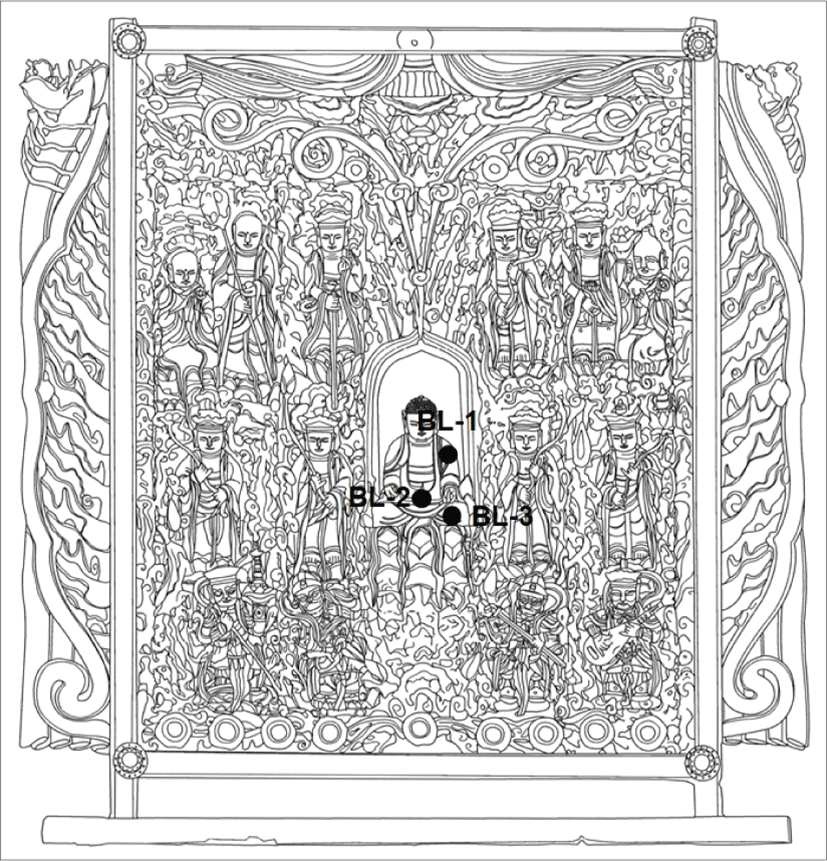
Above the base layer, pigment layer and orange pigment layer was observed and 1–2 gold layers were found above them. Ash, bone-dust, clay-dust, etc. from base layer were checked through polarized light observation, but none was found. In the microscope observation, tradition varnish such as lacquer can be observed as light brown and brown color. However, Yellowish varnish was observed in this sample. It seems to be modern chemical varnish and polymers were used in the previous conservation work (Fig. 55–57).



Lacquer layer analysis of Buddha Triad showed that an orange pigment layer was above two lacquer layers, which were above two base layers. Also, a gold leaf layer is found above the orange pigment layer. Lacquer layer appears brown−light brown color when observed (Choi, 2017; Kim, 2007). However, the orange pigment layer found above the lacquer layer appears to be modern synthetic chemical varnish used during previous conservation works. Korean wooden Buddha sculptures are crafted by coating lacquer on the surface, plating with gold, and painting using pigment as tradition method. However, some pigments assumed to be used in modern era is analyzed from the Buddha Triad and Buddha Altarpiece. Synthetic pigment and paint were introduced in modern age, and is likely to have been used for previous conservation works. Moreover, the back of Buddha Altarpiece was indiscreetly painted with orange color pigment composed of cadmium red and minium, and areas with exfoliated gold leaf were likely painted with yellow color pigment. As a scientific analysis result show that whole part of Buddha Triad and Buddha Altarpiece were damaged by several factors.
4. CONCLUSIONS
Material analysis results show that sculptures were made of lime tree, soft pine and hard pine which were used to craft wooden sculpture for the prolonged period of Korea. Lacquer layer, gold leaf layer and pigment analysis result show that synthetic varnish and modern pigments were partially used. Also conservation status can be diagnosis through the visual inspection. Korean cultural heritage charter and the international charter for the conservation and restoration of monuments and sites clearly state that cultural heritages must be conserved using its original material (Choi, 2008; Lee & Do, 1998). Thus, conservation processes must replace such modern pigments and varnishes with Korean traditional materials. Therefore, conservation treatment must utilize this database and be conducted with traditional materials. Furthermore, deterioration map diagnosis for the understanding of conservation status and scientific analysis data can be applied for the appropriate and authentic conservation treatment of Buddha Triad and Altarpiece.

